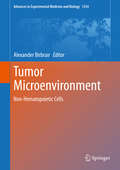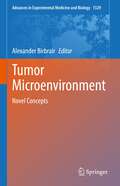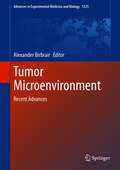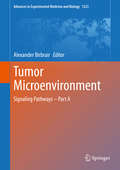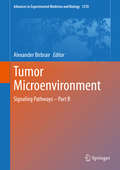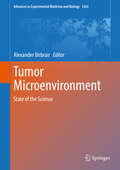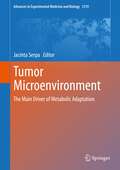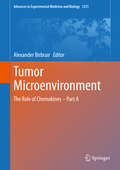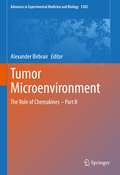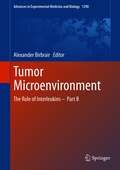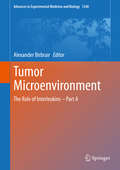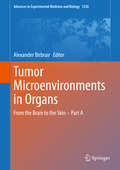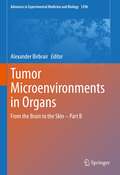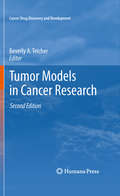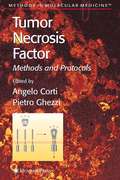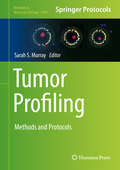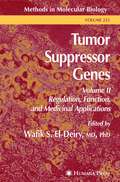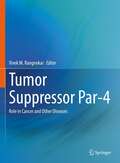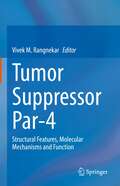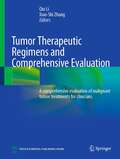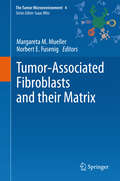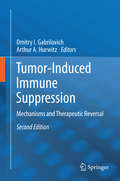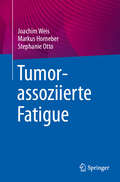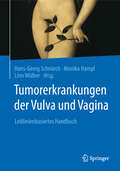- Table View
- List View
Tumor Microenvironment: Non-Hematopoietic Cells (Advances in Experimental Medicine and Biology #1234)
by Alexander BirbrairRevealing essential roles of the tumor microenvironment in cancer progression, this volume focuses on non-hematopoietic cells within the tumor microenvironment.Further, it teaches readers about the roles of distinct constituents of the tumor microenvironment and how they affect cancer development. Topics include fibroblasts, adipocytes, mesenchymal stem cells, stellate cells, and more. Taken alongside its companion volumes, Tumor Microenvironment: Non-Hematopoietic Cells updates us on what we know about the different aspects of the tumor microenvironment as well as future directions. Useful for introducing the newer generation of researchers to the history of how scientists focused in the tumor microenvironment and how this knowledge is currently applied for cancer treatments, it will be essential reading for advanced cell biology and cancer biology students as well as researchers seeking an update on research in the tumor microenvironment.All of the chapter authors are renowned international experts in the cancer biology field in specific subfields that will be the focus of their chapters.
Tumor Microenvironment: Novel Concepts (Advances in Experimental Medicine and Biology #1329)
by Alexander BirbrairThis volume discusses novel concepts in cancer biology, focusing on different factors that affect the tumor microenvironment. Topics covered include sex-based differences in the tumor microenironment, dormancy in the tumor microenvironment, the influence of obesity on the tumor microenvironment, and much more. Taken alongside its companion volumes, Tumor Microenvironment: Novel Concepts covers the latest research on various aspects of the tumor microenvironment, as well as future directions. Useful for introducing the newer generation of researchers to the history of how scientists studied the tumor microenvironment as well as how this knowledge is currently applied for cancer treatments, it will be essential reading for advanced cell biology and cancer biology students, as well as researchers seeking an update on research on the tumor microenvironment.
Tumor Microenvironment: Recent Advances (Advances in Experimental Medicine and Biology #1225)
by Alexander BirbrairThis volume discusses recent research advances in cancer biology, focusing on the role of the tumor microenvironment. Taken alongside its companion volumes, Tumor Microenvironment: Recent Advances covers the latest research on various aspects of the tumor microenvironment, as well as future directions. Useful for introducing the newer generation of researchers to the history of how scientists studied the tumor microenvironment as well as how this knowledge is currently applied for cancer treatments, it will be essential reading for advanced cell biology and cancer biology students, as well as researchers seeking an update on research on the tumor microenvironment.
Tumor Microenvironment: Signaling Pathways – Part A (Advances in Experimental Medicine and Biology #1223)
by Alexander BirbrairRevealing essential roles of the tumor microenvironment in cancer progression, this book provides a comprehensive overview of the latest research on how different signaling pathways are important in the tumor microenvironment. Multiple signaling pathways are covered, including S1P, neuregulin, Notch, erythropoietin, Rho-ROCK, mTOR, and more.Taken alongside its companion volumes, these books update us on what we know about various aspects of the tumor microenvironment as well as future directions. Tumor Microenvironment: Signaling Pathways – Part A is essential reading for advanced cell biology and cancer biology students as well as researchers seeking an update on research in the tumor microenvironment.
Tumor Microenvironment: Signaling Pathways – Part B (Advances in Experimental Medicine and Biology #1270)
by Alexander BirbrairRevealing essential roles of the tumor microenvironment in cancer progression, this book provides a comprehensive overview of the latest research on how different signaling pathways are important in the tumor microenvironment. Multiple signaling pathways are covered, including Src, Neuregulin, Adenosine, TGFβ, Androgen, Wnt, and more.Taken alongside its companion volumes, these books update us on what we know about various aspects of the tumor microenvironment as well as future directions. Tumor Microenvironment: Signaling Pathways – Part B is essential reading for advanced cell biology and cancer biology students as well as researchers seeking an update on research in the tumor microenvironment.
Tumor Microenvironment: State of the Science (Advances in Experimental Medicine and Biology #1263)
by Alexander BirbrairRevealing essential roles of the tumor microenvironment in cancer progression, this book provides a comprehensive overview of the latest research in the field. A variety of topics are covered, including metabolism in the tumor microenvironment, stellate cells and endothelial progenitors in the tumor microenvironment, as well as the effects of HIV, viral hepatitis, and inflammation in the tumor microenvironment, and more. Taken alongside its companion volumes, Tumor Microenvironment: State of the Science updates us on what we know about various aspects of the tumor microenvironment, as well as future directions. This book is essential reading for advanced cell biology and cancer biology students as well as researchers seeking an update on research in the tumor microenvironment.
Tumor Microenvironment: The Main Driver of Metabolic Adaptation (Advances in Experimental Medicine and Biology #1219)
by Jacinta SerpaThe way a cell undergoes malignant transformation should meet their capacity of surviving in the microenvironment of the organ where the cancer will develop. Metabolic adaptation is for sure one of the criteria that must be accomplished, driven by metabolic plasticity that allows the adaptation of cancer cells to the availability of energy and biomass sources that will sustain cell survival and proliferation. Each human organ has a particular microenvironment which depends on several cell types and in some cases also on symbiotic microorganisms. These biological partners are constantly sharing organic compounds and signaling molecules that will control mitogenesis, cell death and differentiation, accounting for the organ's function. Nevertheless, cancer cells are capable of taking advantage of this metabolic and signaling microenvironmental dynamics.In this book, we intend to present the different components of the microenvironment driving the metabolic fitness of cancer cells. The metabolic changes required for establishing a tumor in a given microenvironment and how these metabolic changes limit the response to drugs will generally be the major items addressed. It is important to mention not only aspects of the microenvironment that stimulate metabolic changes and that select better adapted tumor cells, but also how this regulation of cell plasticity is made. Thus, the signaling pathways that orchestrate and are orchestrated throughout this panoply of metabolic rearrangements will also be addressed in this book. The subjects will be presented from the conceptual point of view of the cross-cancer mechanisms and also particularizing some models that can be examples and enlightening within the different areas.
Tumor Microenvironment: The Role of Chemokines – Part A (Advances in Experimental Medicine and Biology #1231)
by Alexander BirbrairRevealing essential roles of the tumor microenvironment in cancer progression, this book provides a comprehensive overview of the latest research on the role of chemokines in the tumor microenvironment. Each chapter focuses on the chemokines patterns of expression, their regulation, and their roles in immune cell recruitment, as well as how they affect cancer immunity and tumorigenesis. Taken alongside its companion volumes, Tumor Microenvironment: The Role of Chemokines – Part A updates us on what we know about various aspects of the tumor microenvironment as well as future directions. This book is essential reading for advanced cell biology and cancer biology students as well as researchers seeking a comprehensive update on research in the tumor microenvironment.
Tumor Microenvironment: The Role of Chemokines – Part B (Advances in Experimental Medicine and Biology #1302)
by Alexander BirbrairRevealing essential roles of the tumor microenvironment in cancer progression, this book provides a comprehensive overview of the latest research on the role of chemokines in the tumor microenvironment. Each chapter focuses on the chemokines patterns of expression, their regulation, and their roles in immune cell recruitment, as well as how they affect cancer immunity and tumorigenesis.Taken alongside its companion volumes, Tumor Microenvironment: The Role of Chemokines – Part B updates us on what we know about various aspects of the tumor microenvironment, as well as apprises us on future directions in the field. This book is essential reading for advanced cell biology and cancer biology students as well as scientists seeking an update on recent developments and research in the tumor microenvironment.
Tumor Microenvironment: The Role of Interleukins – Part B (Advances in Experimental Medicine and Biology #1290)
by Alexander BirbrairRevealing essential roles of the tumor microenvironment in cancer progression, this book provides a comprehensive overview of the latest research on the role of interleukins in the tumor microenvironment. Each chapter focuses on the various ways to target the tumor microenvironment by intervention in the interleukin biology, including IL-6, IL-7, IL-10, IL-12, IL-22, IL-23, and IL-24 signaling.Taken alongside its companion volumes, Tumor Microenvironment: The Role of Interleukins – Part B updates us on what we know about various aspects of the tumor microenvironment, as well as future directions. This book is essential reading for advanced cell biology and cancer biology students as well as researchers seeking an update on research in the tumor microenvironment.
Tumor Microenvironment: The Role of Interleukins – Part A (Advances in Experimental Medicine and Biology #1240)
by Alexander BirbrairRevealing essential roles of the tumor microenvironment in cancer progression, this book provides a comprehensive overview of the latest research on the role of interleukins in the tumor microenvironment. Each chapter focuses on the various ways to target the tumor microenvironment by intervention in the interleukin biology, including IL-1, IL-8, IL-21, IL-36 signaling, and more. Taken alongside its companion volumes, Tumor Microenvironment: The Role of Interleukins – Part A updates us on what we know about various aspects of the tumor microenvironment, as well as future directions. This book is essential reading for advanced cell biology and cancer biology students as well as researchers seeking an update on research in the tumor microenvironment.
Tumor Microenvironments in Organs: From the Brain to the Skin – Part A (Advances in Experimental Medicine and Biology #1226)
by Alexander BirbrairRevealing essential roles of the tumor microenvironment in cancer progression, this book provides a comprehensive overview of the latest research on the tumor microenvironment in over thirty human organs, including the parathyroid gland, heart, intestine, testicles, and more.Taken alongside its companion volumes, these books update us on what we know about the different aspects of the tumor microenvironments in distinct organs as well as future directions. Tumor Microenvironments in Organs: From the Brain to the Skin – Part A is essential reading for advanced cell biology and cancer biology students as well as researchers seeking an update on research in the tumor microenvironment.
Tumor Microenvironments in Organs: From the Brain to the Skin – Part B (Advances in Experimental Medicine and Biology #1296)
by Alexander BirbrairRevealing essential roles of the tumor microenvironment components in cancer progression, this book provides a comprehensive overview of the latest research on the tumor microenvironment in several organs, including brain, neck, tongue, larynges, esophagus, carotid body, breast, prostate, ovary, endometrium, liver, pancreas, bladder, penis, seminal vesicle, retina, and pituitary, pineal and sweat glands, and more.Taken alongside its companion volumes, Tumor Microenvironments in Organs: From the Brain to the Skin – Part B updates us on what we know about the different aspects of the tumor microenvironments in distinct organs as well as future directions. This book is essential reading for advanced cell biology and cancer biology students as well as researchers seeking an update on research in the tumor microenvironment.
Tumor Models in Cancer Research
by Beverly A. TeicherThe past 6 years since the first edition of this book have seen great progress in the development of genetically engineered mouse (GEM) models of cancer. These models are finding an important role in furthering our understanding of the biology of malignant disease. A comfortable position for GEM models in the routine conduct of screening for potential new therapeutics is coming more slowly but is coming. Increasing numbers of genetically engineered mice are available, some with conditional activation of oncogenes, some with multiple genetic changes providing mouse models that are moving closer to the human disease.
Tumor Necrosis Factor
by Angelo Corti Pietro GhezziA comprehensive collection of readily reproducible techniques for TNF production, characterization, mutagenesis, and detection in biological specimens. Also included are several in vitro assays and animal models for studying the role of TNF in various TNF-related diseases and in cancer. The collection offers molecular and cellular biologists, pharmacologists, and toxicologists a diverse set of versatile, cutting-edge tools for illuminating the pathophysiological roles of TNF in disease and for identifying new drugs.
Tumor Profiling: Methods And Protocols (Methods In Molecular Biology Series #1908)
by Sarah S. MurrayThis book provides a practical guide to current methods for profiling and interpreting genomic alterations in tumors. Chapters detail methods to interrogate DNA variation, RNA expression, and epigenetic changes using both next-generation sequencing and microarray techniques, common bioinformatics and annotation tools to glean relevant driver genomic events, and different performance characteristics as well as quality metrics necessary for the robust validation of tumor profiling as a diagnostic test for medical laboratories. Written in the highly successful Methods in Molecular Biology series format, chapters include introductions to their respective topics, lists of the necessary materials and reagents, step-by-step, readily reproducible laboratory protocols, and tips on troubleshooting and avoiding known pitfalls. Authoritative and cutting-edge, Tumor Profiling: Methods and Protocols aims to be a useful resource for learning about technical details, applications, and strengths and limitations of the latest technologies as applied to this increasingly important field.
Tumor Suppressor Genes, Volume 1: Pathways and Isolation Strategies
by Wafik S. El-DeiryLeading physician scientists and academic researchers review all the known tumor suppressor genes, explain how they work, and describe how they were discovered and isolated. In many cases, the authors discuss specific genes that are frequently involved in hereditary or sporadic cancers. They also provide a detailed guide to using powerful molecular genetic, cytogenetic, proteomic, and cell biological strategies to discover and isolate novel tumor suppressor genes and their targets. <P><P> For both volumes:<P> Leading physician scientists and academic researchers review all the known tumor suppressor genes, explain how they work, and describe how they were discovered and isolated. In many cases, the authors discuss specific genes that are frequently involved in hereditary or sporadic cancers. They also provide a detailed guide to using powerful molecular genetic, cytogenetic, proteomic, and cell biological strategies to discover and isolate novel tumor suppressor genes and their targets. A second volume of this two-volume set, Tumor Suppressor Genes, Volume 2: Regulation, Function, and Medical Applications, shows how to explore the cell biology and biochemical function of such encoded proteins, to study its physiological role in vivo, and to use information on TSGs to develop diagnostic and therapeutic strategies for cancer.
Tumor Suppressor Genes, Volume 2: Regulation, Function, and Medicinal Applications
by Wafik S. El-DeiryLeading physician scientists and academic researchers review all the known tumor suppressor genes, explain how they work, and describe how they were discovered and isolated. In many cases, the authors discuss specific genes that are frequently involved in hereditary or sporadic cancers. They also provide a detailed guide to using powerful molecular genetic, cytogenetic, proteomic, and cell biological strategies to discover and isolate novel tumor suppressor genes and their targets. <P><P> For both volumes:<P> Leading physician scientists and academic researchers review all the known tumor suppressor genes, explain how they work, and describe how they were discovered and isolated. In many cases, the authors discuss specific genes that are frequently involved in hereditary or sporadic cancers. They also provide a detailed guide to using powerful molecular genetic, cytogenetic, proteomic, and cell biological strategies to discover and isolate novel tumor suppressor genes and their targets. A second volume of this two-volume set, Tumor Suppressor Genes, Volume 2: Regulation, Function, and Medical Applications, shows how to explore the cell biology and biochemical function of such encoded proteins, to study its physiological role in vivo, and to use information on TSGs to develop diagnostic and therapeutic strategies for cancer.
Tumor Suppressor Par-4: Role in Cancer and Other Diseases
by Vivek M. RangnekarPar-4 is a naturally occurring tumor suppressor. Studies have indicated that overexpression of Par-4 selectively induces apoptosis in cancer cells while leaving normal, health, cells unaffected. Mechanisms contributing to this cancer-selective action of Par-4 have been associated with PKA activation of intracellular Par-4 in cancer cells or GRP78 expression primarily on the surface of cancer cells. On the other hand, endogenous Par-4 sensitizes cells to the action of a broad range of apoptotic inducers acting via the extrinsic and intrinsic pathways. A number of binding partners of Par-4 have been identified and shown to regulate Par-4 function in cancer and other diseases, such as Alzheimer’s and major depression. Recent studies have recognized a number of natural products, dietary supplements, synthetic molecules and FDA-approved drugs that induce the secretion of Par-4 protein to cause apoptosis in primary or metastatic tumors, one of which is in clinical trials. More than 50 different laboratories worldwide are involved in Par-4 based research of this unique protein that has progressed from the bench to clinical trials. This second, companion volume will provide a comprehensive overview of Par-4’s role in cancer and other diseases. Chapters are written by leading researchers, and will be useful for a broad audience across the scientific community, particularly students and trainees, who are the next generation of scientists and clinicians to participate in new studies and discoveries on Par-4.
Tumor Suppressor Par-4: Structural Features, Molecular Mechanisms and Function
by Vivek M. RangnekarPar-4 is a tumor suppressor protein first discovered and identified in 1993 by Dr. Vivek Rangnekar’s laboratory in prostate cancer cells undergoing apoptosis. Par-4 (later also known as PAWR) is a naturally occurring tumor suppressor. Studies have indicated that Par-4 selectively induces apoptosis in cancer cells while leaving normal, healthy, cells unaffected. Mechanisms contributing to the cancer-selective action of Par-4 have been associated with protein kinase A activation of intracellular Par-4 in cancer cells or GRP78 expression primarily on the surface of cancer cells. Par-4 is downregulated, inactivated or mutated in diverse cancers. This first of two volumes will be the first on the market on the topic of Par-4, and will provide the opportunity for researchers to discuss the future direction of studies, broaden the scope of research, and contribute a more complete understanding of the molecule’s structural features, key functional domains, regulation and relevant basic and clinical/translational facets.
Tumor Therapeutic Regimens and Comprehensive Evaluation: A comprehensive evaluation of malignant tumor treatments for clinicians
by Qiu Li Xiao-Shi ZhangThis book starts from the clinical reality, take practicality as the purpose, closely integrate clinical work, including important clinical therapeutic regimens for various cancer, and describes the new developments in treatment of common malignant tumors. At the same time, in combination with improved version of the ASCO value framework, systematic and standardized comparisons and in-depth evaluations of therapeutic regimens were made to promote the standardization of medical treatment decisions for malignant tumors. Compared with the traditional evaluation method of malignant tumor therapeutic regimens, the evaluation method of this book has outstanding advantages. First, the evaluation indicators are comprehensive and diverse. The evaluation includes multiple indicators such as clinical benefits, adverse reactions, additional benefits, and costs, and includes more effective evaluation indicators to comprehensively evaluate the treatment plan. Second, the evaluation indicators are converted into numerical values, and different indicators are effectively quantified to make the result evaluation easier and more objective. This book systematically and comprehensively reflects the highest level of diagnosis and treatment of common oncology from a new perspective. It has great clinical guidance value and will be a valuable reference book for clinicians, medical students, graduate students and related researchers.
Tumor-Associated Fibroblasts and their Matrix
by Margareta M. Mueller Norbert E. FusenigDuring the last 20 years it has become increasingly clear that the tumor micro-environment, the tumor stroma with its cellular end extracellular components, plays an crucial role in regulating tumor growth and progression. This book on "Tumor-associated fibroblasts and their matrix" as part of the series on "Tumor-Microenvironment" is the first comprehensive discussion of these two main players of the tumor microenvironment. The best experts in this new area of tumor research and therapy review the role of these major components in the tumor stroma in the process of tumor development and progression. They discuss their interaction with other players such as blood vessels and immune cells, and show novel perspectives for tumor therapy. This compilation of excellent contributions of the best known experts in this important field in cancer research and therapy is a must for all scientists engaged in basic and clinical research. Increasing evidence of successful targeting of both cellular and matrix components in tumor therapy renders this book of particular interest for scientists engaged in pharmaceutical industry searching for new components for cancer therapy.
Tumor-Induced Immune Suppression
by Dmitry I. Gabrilovich Arthur Andrew HurwitzTumor-Induced Immune Suppression - Prospects and Progress in Mechanisms and Therapeutic Reversalpresents a comprehensive overview of large number of different mechanisms of immune dysfunction in cancer and therapeutic approaches to their correction. This includes the number of novel mechanisms that has never before been discussed in previous monographs. The last decades were characterized by substantial progress in the understanding of the role of the immune system in tumor progression. Researchers have learned how to manipulate the immune system to generate tumor specific immune response, which raises high expectations for immunotherapy to provide breakthroughs in cancer treatment. It is increasingly clear that tumor-induced abnormalities in the immune system not only hampers natural tumor immune surveillance, but also limits the effect of cancer immunotherapy. Therefore, it is critically important to understand the mechanisms of tumor-induced immune suppression to make any progress in the field and this monograph provides these important insights.
Tumorassoziierte Fatigue
by Joachim Weis Markus Horneber Stephanie OttoDieses Buch beleuchtet die tumorassoziierte Fatigue, welche Patientinnen und Patienten mit bösartigen Tumoren in allen Phasen der Erkrankung treffen kann, ob als frühes Zeichen, während und nach der onkologischen Therapie, oder als Langzeitfolge. Nach einer kurzen Einführung in Epidemiologie, Ätiologie, Pathogenese und Diagnostik stellen Autorin und Autoren praxisorientiert und prägnant die verschiedenen Behandlungsansätze und Möglichkeiten des Selbstmanagements vor. Diese umfassen nicht-medikamentöse Therapien, wie Bewegungstherapie, psychosoziale und Mind-Body Interventionen sowie medikamentöse Therapien. Ziel des Buchs ist es, Behandelnde zu unterstützen, die individuell effektivsten Therapieoptionen zu finden, um das Syndrom erfolgreich zu behandeln und die Lebensqualität der Betroffenen zu verbessern: Ärztinnen und Ärzte in der Onkologie, Allgemeinmedizin und Inneren Medizin.
Tumorerkrankungen der Vulva und Vagina: Leitlinienbasiertes Handbuch
by Hans-Georg Schnürch Monika Hampl Linn WölberRenommierte Kliniker und Experten führen in diesem Buch durch alle relevanten Aspekte der Neoplasien von Vulva und Vagina. Gynäkologen und Onkologen wird damit alles Wissenswerte zu Ätiologie, Epidemiologie, Pathologie, Diagnostik, zu Therapieoptionen sowie zur medizinischen Nachsorge angeboten – basierend auf den aktuellen Leitlinien zu den Malignomen von Vulva und Vagina. Erfahren und kenntnisreich geben Herausgeber und Autoren den behandelnden Ärzten das nötige praxisrelevante Wissen an die Hand, um ihre Patientinnen optimal zu versorgen und deren Heilungschancen zu verbessern.
